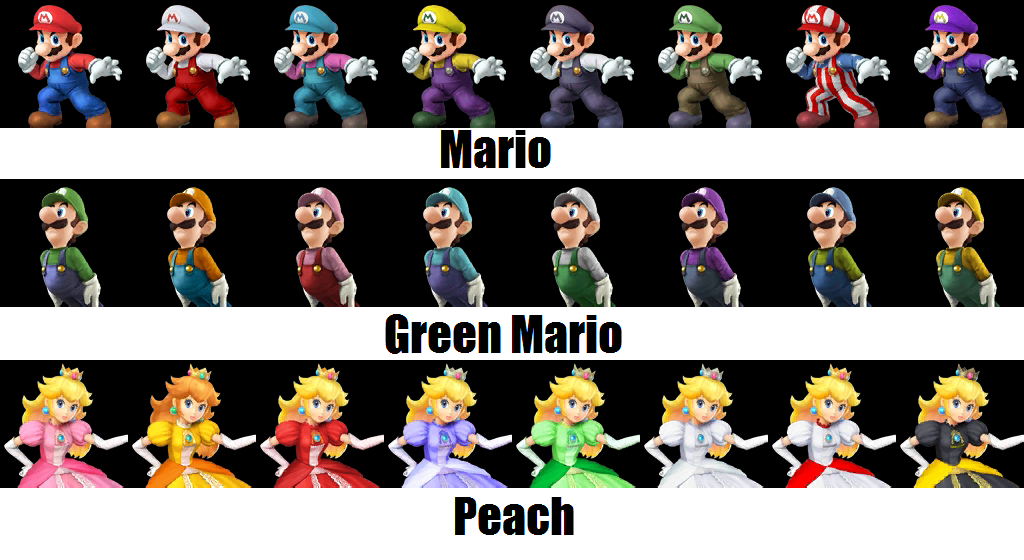


Palette swaps can be used to make Underground Monkeys, different colors to show different elemental affinities with Color-Coded Elements, Palette-Swapped Alien Food, or just a different variant. For the level/world equivalent, see Remixed Level and Hard Mode Filler. Separate, but Identical is this trope for strategy games, which can also be Palette Swaps. Often associated with Moveset Clone in fighting games. See also Colour-Coded for Your Convenience. This can sometimes result in most of the line effectively being the same character with a different head and accessories, and is a major reason for the prevalence of the Environment-Specific Action Figure.įor a similar time-saving technique, see Ambidextrous Sprite. Outside of videogames, nearly all toylines will reuse parts with some colors changed, as much of the cost of a new toy comes from making the steel injection mold used to create parts. Palette Swaps are also used in Sprite Comics, where they're known as recolors.
#SUPER SMASH CHROM PALETTE SWAP TV#
One of the best ways developers found to make this trope smarter and loved by the audience, is use it as references, usually to other aspects of a franchise, when videogames have sequels, characters can have their original clothes from previous games back, superheroes in videogames can have multiple uniforms from their history in comics, TV shows and movies, characters who were completely redesigned over the years or with reboots can get reverted to their original designs, characters who appeared or debuted in the early days of 3D graphics like the PlayStation 1 or the Nintendo 64 can get turned into their low-poly models from those times, and even pallete swaps that are just alternate colors can work as references, this trope can also be used to reference other unrelated works. In the case of bosses it can be used to hint at relationships between creatures that might not otherwise be apparent to the player. Also, can be used for worldbuilding: using palette-swapped monsters can hint at connections between otherwise disparate locations. This is especially important when a given area is intended to be fast-paced or lead up to a climax, and the designers don't want the player stopping constantly to study "new" enemies. Palette swapping may be a shortcut, but it does allow designers to create enemies that keep pace with the player's progress while still hinting that the enemies will follow a familiar pattern. Individual characters may also have a choice of several different colors or costumes (or both).Ĭaution: Tropes Are Tools. Such characters are also known as "clones". Some fans of fighting games use the term to refer to characters that use the same animations and move sets, even if the characters look very different. Sometimes even bosses are simply re-textured and are huge versions of weaker monsters. Palette Swap to the rescue! By changing the size and textures used on the same model, the designers can make many types of monsters from only a few basic meshes. Massively Multiplayer Online Roleplaying Games ( MMORPGs) are often set in a very large world that must be populated by monsters. The Head Swap is another tried-and-true technique for making more out of less. While the concept is a little different, these are often called Palette Swaps anyway as they're still easier for developers to make than a full-fledged alternate costume or character. The most famous group of these are probably the Slimes, topped by the powerful Metal Slime, of Dragon Quest fame.Ī more elaborate variation found in 3D games is the Texture Swap, where the textures on the character's uniform are changed, but the actual model used remains the same. Palette Swapping was used to create a large variety of different enemies, often using different colors for various power levels. In the 8- and 16-bit era RPGs, it was pervasive: because of console limitations, disk and screen space were serious concerns. In fighting games, this is commonly used to differentiate players using the same character, but it is also employed to create "new" characters. This is seen in some platformers, but it most often appears in Role Playing Games and Fighting Games. One cost-effective method for increasing the variety of game characters is to reuse the same sprite, but using a different color palette.


In 2D game development, the creation of sprites is labor-intensive.


 0 kommentar(er)
0 kommentar(er)
